Rich timber tones: the latest home interior design wood trend
by Jess Hodges, Interior Design Manager
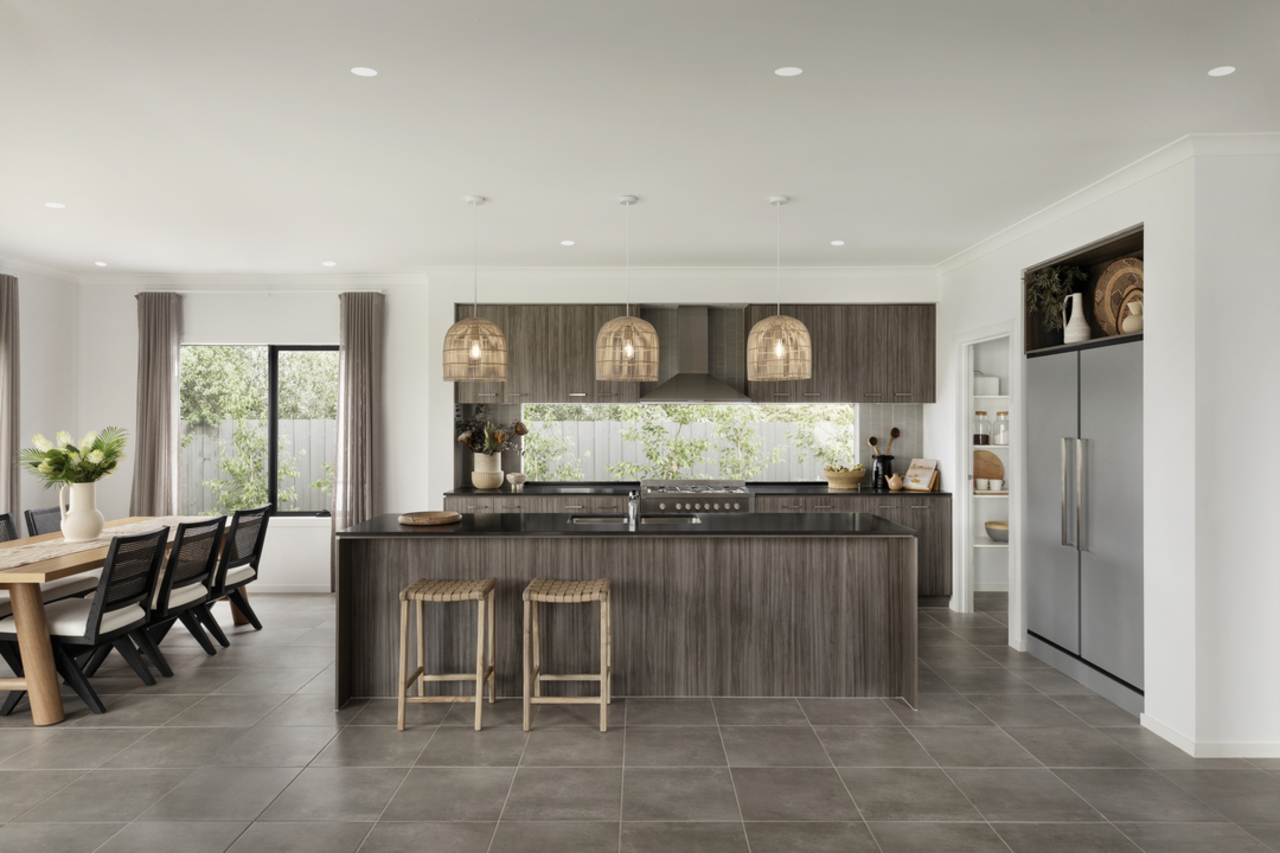
7 ways to use warm timber tones, straight from our design specialists
Over the past few years, we’ve seen a major shift in interior design. Pale wood tones - once the darling of modern homes- are stepping aside for something bolder, richer, and undeniably timeless. Enter rich timber tones: walnut, mahogany, blackened oak, and elm, bringing depth and elegance to every space they touch.
Why the change? It’s part of a broader movement toward natural textures and earthy palettes. Homeowners are leaning into designs that feel grounding, warm, and connected to nature. Rich timbers align perfectly with this ethos, creating spaces that are both sophisticated and welcoming.
This blog will explore how to use wood with deep, rich timber tones in your home, from cabinetry to feature walls, and give you tips on creating balance with complementary materials and colours.
Here’s what we’re going to cover:
- Seven ways to bring rich timber tones into your interiors
- The perfect colours and materials to pair with dark timber
- Tips for styling timber tones with confidence
- Sustainable options for eco-conscious design
- Real-life inspiration from Carlisle Homes display homes
Rich timber tones: A trend for every design aesthetic
One of the reasons we’re so excited about rich timber tones is their incredible versatility. Whether your style leans modern and minimalist or classic and cozy, these darker woods can adapt beautifully to suit your aesthetic. Think about it like this:
Modern Minimalism
- Dark timbers bring warmth and character to the clean lines and simplicity of modern minimalist spaces.
- Use blackened oak cabinetry paired with matte black fixtures for a sleek, understated look. Add contrast with white walls and light, neutral furnishings.
Scandi Chic
- Scandinavian interiors often rely on pale woods, but adding rich timber accents can create depth and a more grounded feel.
- Combine walnut furniture with soft, textural elements like sheepskin rugs, linen curtains, and natural light to maintain the signature airy vibe of this style.
Industrial
- Rich timber tones perfectly complement industrial aesthetics, with their focus on raw materials like concrete, metal, and exposed brick.
- Use dark timber flooring or shelving to soften the hardness of industrial elements, and pair them with iron fixtures or aged leather furniture for a cohesive look.
Hamptons Elegance
- Traditionally light and breezy, the Hamptons style takes on a new level of sophistication with the addition of rich timbers.
- Consider using dark timber dining tables or built-in joinery against white walls and coffered ceilings. This creates a striking contrast that feels luxurious yet relaxed.
Mid-Century Modern
- Dark timbers like walnut and teak are staples of mid-century design, making this trend a natural fit for the style.
- Pair a rich timber coffee table or sideboard with tapered legs, retro-inspired lighting, and bold accent colours like mustard or teal for a nostalgic yet contemporary look.
Rustic and Farmhouse
- Dark woods enhance the warmth and coziness of rustic and farmhouse interiors.
- Combine timber panelling with stone fireplaces, vintage-inspired decor, and soft textiles like wool or cotton to create an inviting, lived-in feel.
This versatility is why we love working with rich timber tones - they’re not just a trend, but a timeless design choice that fits beautifully into any style of home. As you explore how to incorporate them into your space, think about how they can enhance your home with warmth and sophistication while also seamlessly blending into your personal aesthetic.
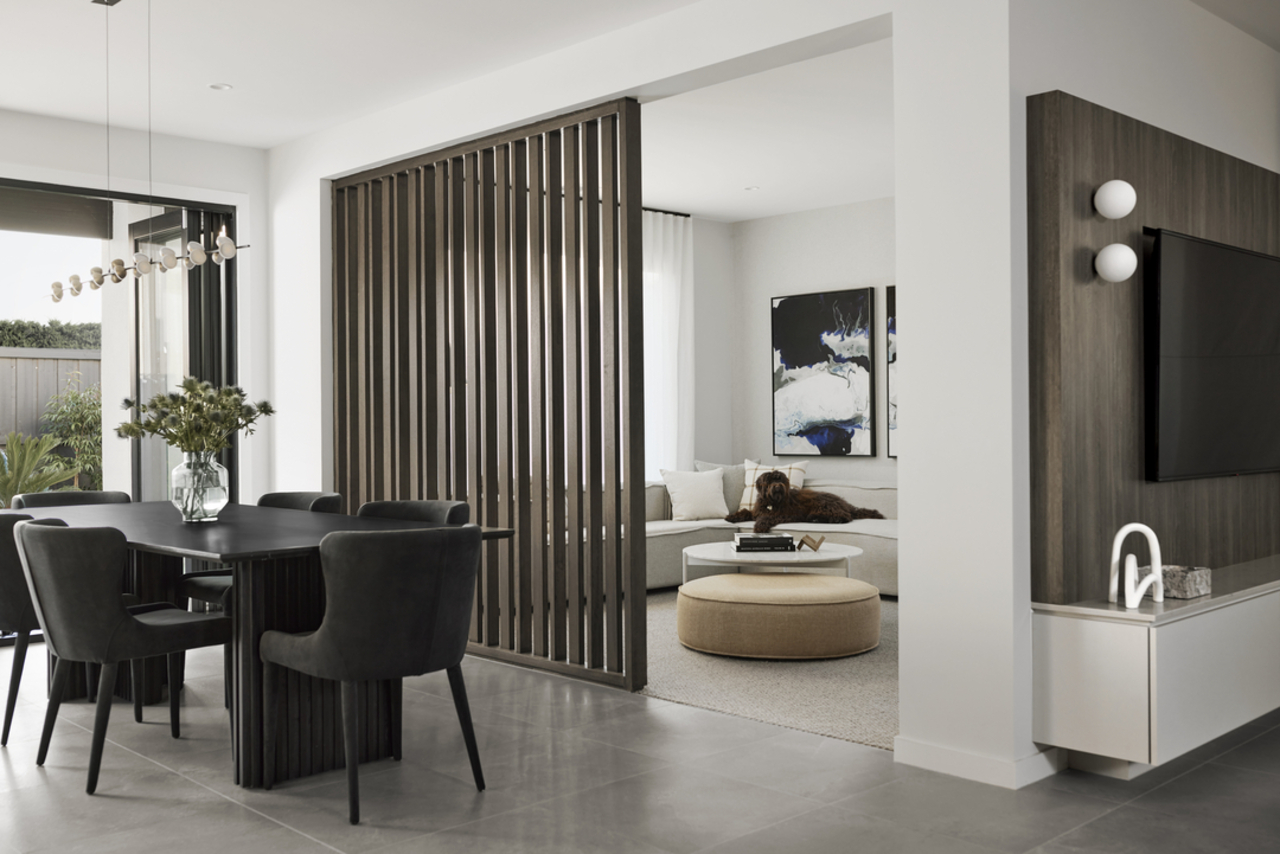
Enrich the heart of your home with darker timber alongside beautifully earth-drawn colours. Featured here: Canterbury Grand, Aurora, Wollert.
7 creative ways to incorporate rich timber tones into your home
Rich timber tones are one of the most versatile design elements we’ve worked with. Over the years, we’ve seen how they can completely transform a home, whether they’re used as a bold statement or as subtle accents. If you’re considering bringing these luxurious tones into your space, here’s how we recommend making them work for you.
1. Add warmth with statement furniture
We’ve found that nothing anchors a room quite like a piece of furniture in rich timber. A walnut dining table, for example, creates an instant focal point in a space, while a blackened oak coffee table adds elegance to your living space. These pieces not only draw the eye but set the tone for the entire room.
One of our favourite combinations is pairing a dark timber dining table with soft, upholstered chairs in linen or velvet. This blend of textures creates a look that’s both sophisticated and welcoming. To finish the space, we often add metallic accents like brass light fixtures or decor to bring out the natural richness of the timber. For more ideas on creating statement pieces, explore our guide on how to make a statement with feature walls.
2. Elevate your floors with dark timber
When it comes to flooring, rich timber tones are a game-changer. They immediately ground a room and create a sense of warmth that pale floors simply can’t achieve. Dark wood can be used in open-plan layouts to tie spaces together seamlessly, giving homes a cohesive and luxurious feel.
If your space is on the smaller side or doesn’t get much natural light, balancing dark floors with light walls and ceilings is a trick we’ve seen work wonders. And don’t forget to layer your floors with rugs in complementary tones—this not only softens the overall look but adds another layer of texture. Need help choosing your flooring? Check out our essential flooring guide.
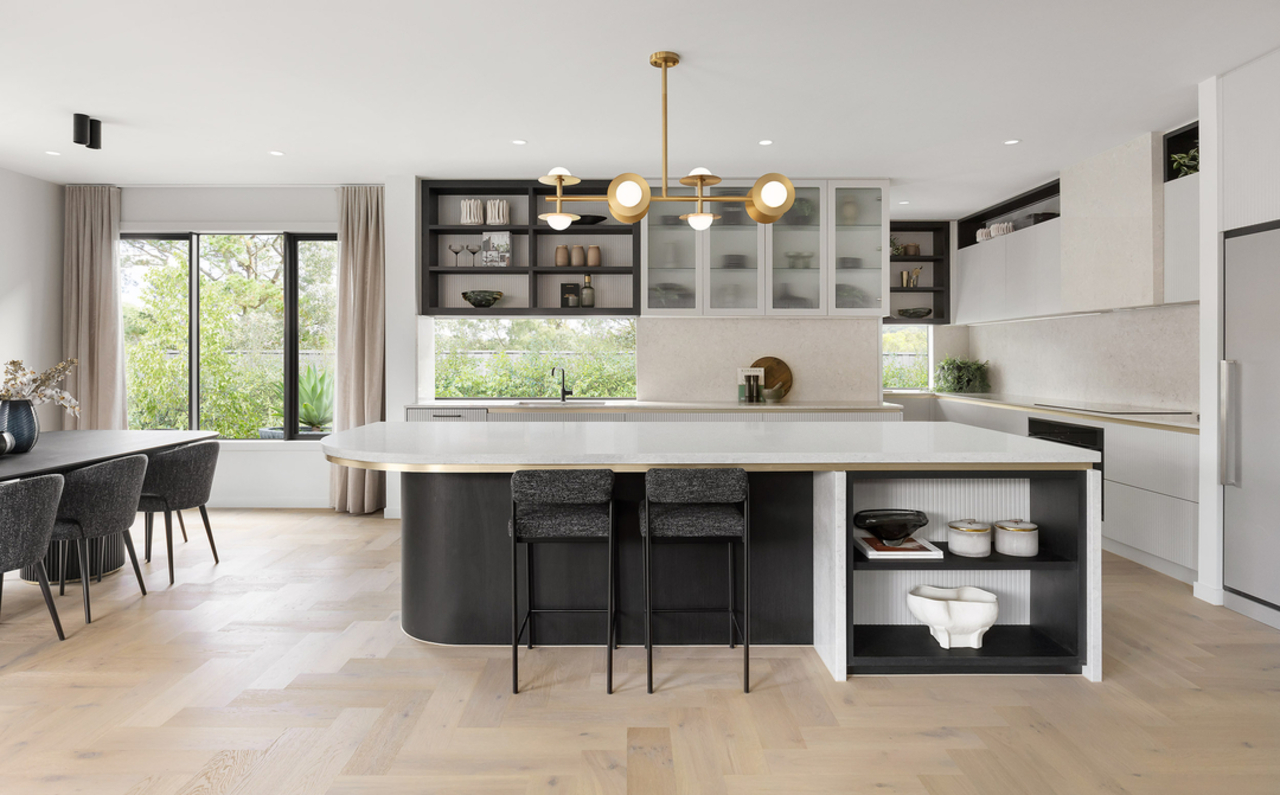
A medley of colours work brilliantly against dark timber accents. Think rich greens, soft pebble, earthy brown and greige tones. Featured here: Astoria Grand Master, Bankside Estate, Rowville.
3. Upgrade your cabinetry and joinery
Dark timber cabinetry is one of our favourite ways to add a sense of sophistication to kitchens and bathrooms. Whether it’s a sleek, blackened oak island or walnut vanities, cabinetry in rich timber tones has a timeless appeal that instantly elevates a space.
In our display homes, we’ve found that pairing timber cabinetry with brushed brass hardware creates a modern yet classic vibe. And if you want a cohesive look, consider carrying the same timber tones through to shelving or built-in joinery in adjoining spaces—it’s a small detail that ties the whole home together beautifully. For more kitchen inspiration, take a look at 10 steps to creating the perfect kitchen.
4. Make a statement with feature walls and panelling
We often suggest timber panelling to clients looking for an impactful yet understated design element. A feature wall in rich timber tones can completely change the dynamic of a room, adding texture and character. We’ve used it in bedrooms to create cozy retreats and in living rooms to draw the eye without overpowering the space.
If you’re going for a modern look, vertical panels in blackened oak can make ceilings feel higher and rooms more spacious. For a more traditional aesthetic, horizontal shiplap in mahogany adds a tailored, classic charm. The key is to pair the timber with soft furnishings or natural textures to maintain balance and warmth. For even more inspiration, see how you can add impact with feature walls.
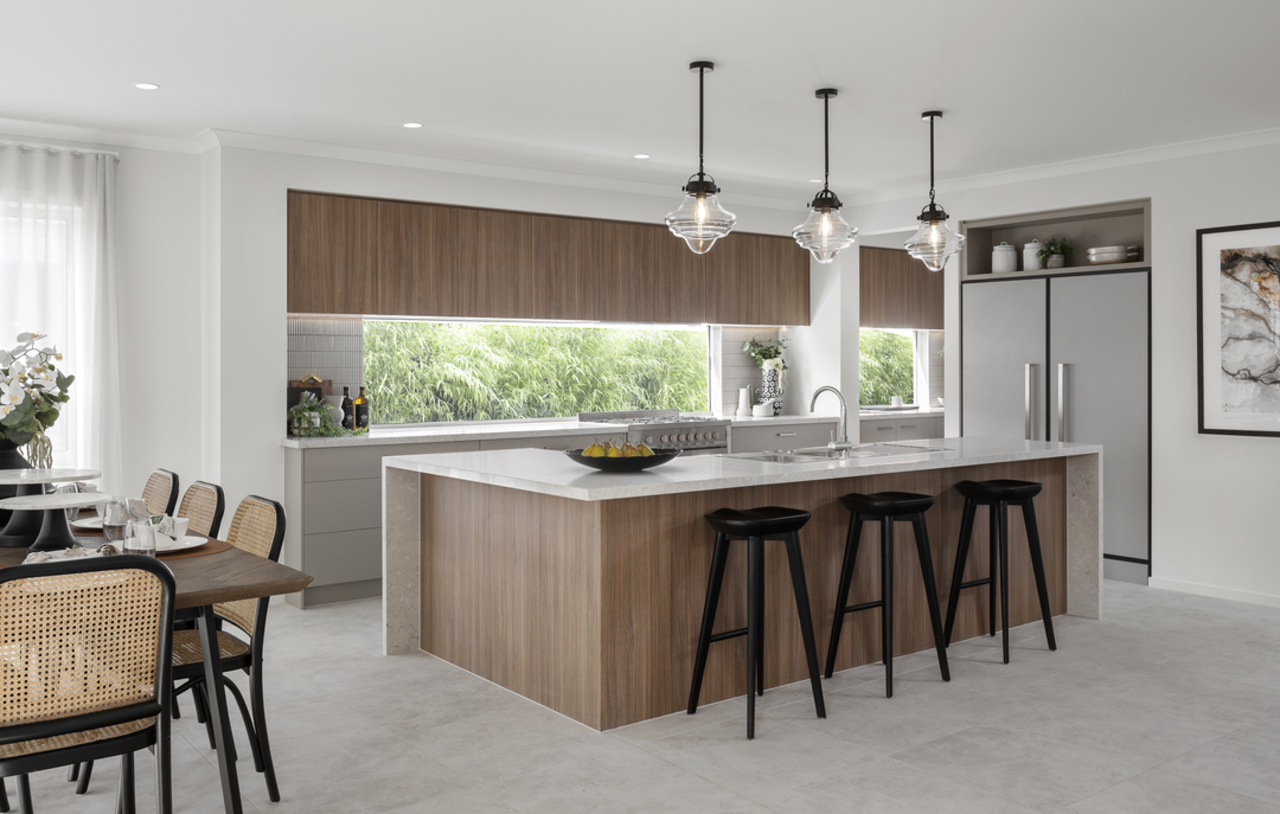
Soften the look by introducing natural materials and organic-inspired decorative pieces.
5. Balance tones with mixed timber accents
Mixing timber tones can feel tricky, but it’s one of the best ways to create depth and dimension in a room. We love pairing darker timbers with lighter ones—like a walnut dining table with pale oak chairs—for a look that feels dynamic yet harmonious.
When mixing timbers, consistency is key. Stick to undertones that complement each other—warm with warm, or cool with cool. In our projects, we often balance darker timbers with lighter floors or cabinetry, allowing each element to shine without overwhelming the space.
6. Use timber for decorative details
If you’re not ready to commit to large pieces, start small with decorative accents. We often recommend timber-framed mirrors, floating shelves, or picture frames to clients looking to introduce rich timber tones in a subtle way. These details add warmth and can tie together a room’s design.
One tip we always share: place dark timber accents in areas that naturally draw attention, like above a mantel or beside a bed. Pairing these elements with ceramics, greenery, or stone accessories can create a beautifully balanced vignette that’s full of character.
7. Extend timber tones to outdoor spaces
Dark timber isn’t just for interiors—we’ve seen how beautifully it works outdoors too. From decking to pergolas, rich timber tones can seamlessly connect your indoor and outdoor spaces, especially if you’re working with large windows or sliding doors.
To make sure your timber holds up to the elements, choose treated materials or composites that mimic the look of natural wood. We’ve also found that pairing timber with lush greenery and outdoor-friendly textiles creates a relaxed, inviting vibe that’s perfect for entertaining. If you're planning an alfresco area or feature stairs, our guide on statement stair design is a great place to start.
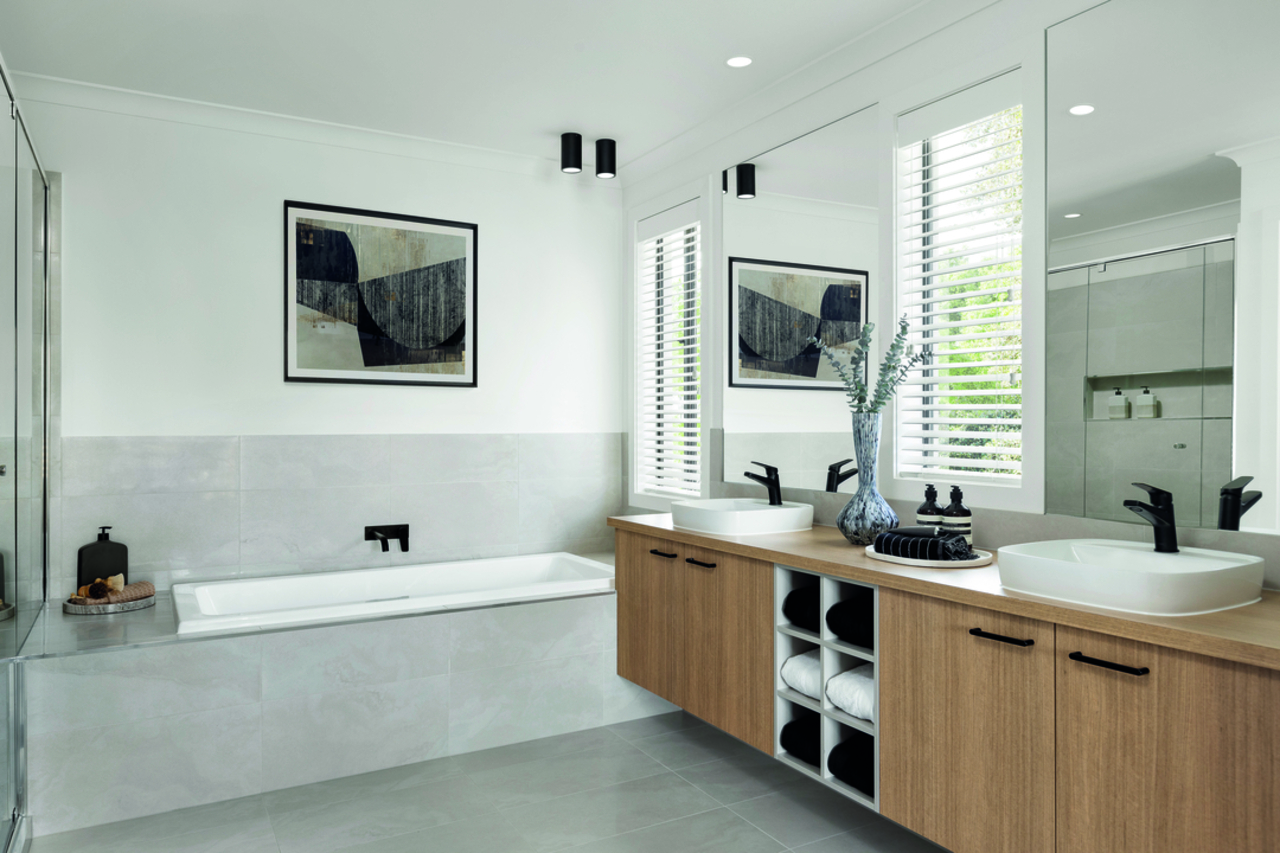
Instil modern, hotel-style luxury in your bathroom with a vanity in walnut and sleek black accent tapware.
10 styling tips for wood interior design ideas
Rich timber tones are a striking design choice, but their full potential lies in how you style them. From the colours you pair them with to the materials and textures you use, the details matter. Here are our expert tips to create a harmonious and visually stunning wood interior design.
1. Balance rich tones with lighter elements
Dark timber tones bring depth and drama to a space, but too much can make a room feel heavy or enclosed. Balance these rich hues with lighter walls, ceilings, or floors to create contrast and a sense of openness.
In rooms in your home where space is limited, pairing blackened oak floors with white walls or neutral tones like greige can keep them looking their best. This combination highlights the timber’s grain pattern and richness while maintaining a sense of airiness.
Adding light, natural materials such as stone or terrazzo can further enhance the look, offering a soft counterpoint to darker woods. These materials not only balance the aesthetic but also add layers of texture and interest.
2. Use complementary colours for harmony
Colour choice can make or break a room featuring dark timber. Pair rich timber tones with earthy hues like sage green, terracotta, or soft taupe to create a cohesive and grounded look.
These colours not only enhance the warmth of wood but also provide contrast that makes timber features stand out. Wood is often used in spaces that prioritise a natural aesthetic, and complementary colours help elevate that look.
Natural materials like wool rugs or ceramic planters in earthy tones can tie the space together beautifully, ensuring your design feels cohesive and grounded.
3. Add texture for depth and interest
Rich timber tones are smooth and refined, so pairing them with textured materials creates a balanced and visually engaging interior. Consider terrazzo, Venetian plaster, or handmade tiles for a touch of rustic sophistication.
Incorporating wooden wall panelling is another way to add depth and texture while showcasing woodwork at its finest. Pair panelling with soft furnishings like linen throws or wool rugs to create a warm and inviting atmosphere.
Adding natural materials such as rattan light fixtures or leather ottomans can further enrich the space, adding both comfort and style. These details bring a tactile element to the design, enhancing your home’s overall ambience.
4. Highlight with metallic accents
Metallic finishes like brass, gold, or matte black are perfect for accentuating the richness of dark timbers. These materials add a touch of glamour while complementing the natural tones of the wood.
Wood to create focal points—such as a blackened oak island with brushed brass fixtures—can transform the feel of a room. These accents also help protect the wood from damage in high-use areas while adding a functional, stylish layer to the design.
For added visual interest, mix metallic accents with matte finishes. This contrast highlights the grain of the timber while bringing contemporary elegance to the space.
5. Use plants to soften and refresh the space
Greenery and timber are a match made in design heaven. The organic forms of plants contrast beautifully with the structured look of timber furniture and panelling, creating a harmonious and balanced environment.
Incorporate plants with rich, leafy greens to enhance the natural beauty of your timber accents. Wood used alongside natural materials like ceramics and terracotta pots can tie the space together, creating a calm and earthy aesthetic.
For darker timbers, adding tall plants like fiddle-leaf figs or cascading greenery can create height and movement in the room, bringing life to your interior design project.
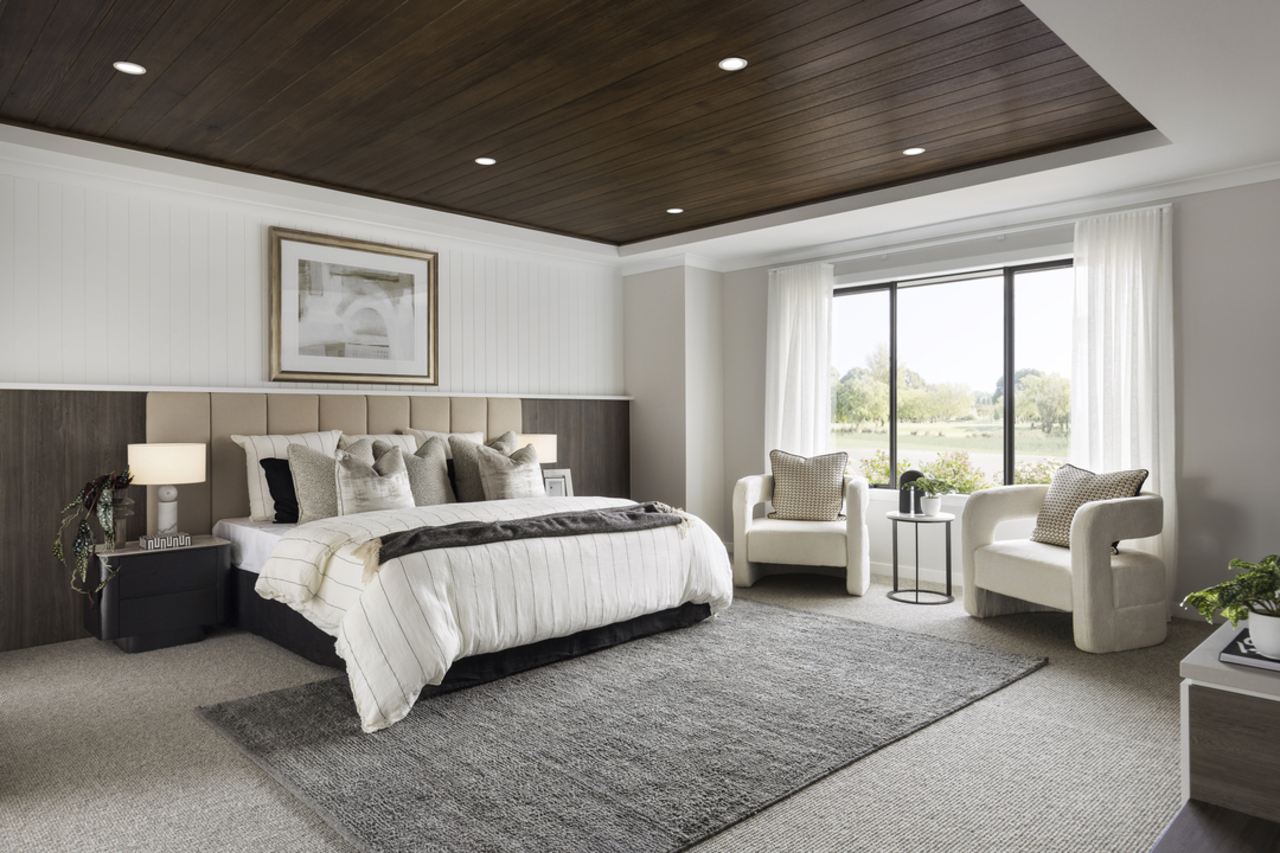
Create impact inside a cocooning retreat by combining dark timber finishes with a rich statement colour, such as charcoal, for your feature wall and bed linen.
.
6. Introduce contrasting wood for depth
Contrasting wood tones can add dimension and interest to a room. For example, pairing walnut cabinetry with lighter oak flooring creates a balanced yet dynamic aesthetic.
This approach works well in modern design projects where subtle variations in wood tones are used to highlight different types of wood. Look for pieces with distinct grain patterns to create visual interest and draw the eye to key elements in the room.
To keep them looking their best, regularly clean and condition timber surfaces with products designed for your specific type of wood. This ensures the natural beauty of your timber remains intact over time.
7. Choose wooden furniture as a focal point
Rich timber tones work beautifully as statement pieces. Wooden furniture like a dining table or console in blackened oak or walnut can transform your home by anchoring the design.
These pieces are perfect for creating a sense of luxury while remaining functional. Place them where they’ll naturally draw attention, such as in a dining room or living area, and style them with complementary decor. Sustainable wood furniture options also add eco-friendly appeal to your home.
Adding throws or cushions in soft fabrics can enhance the comfort of timber furniture while introducing layers of texture to the room.
8. Use beams for architectural interest
Exposed timber beams are a classic way to add architectural charm and a rustic look to a home. Whether left in their natural finish or stained with a rich tone, they can add character to ceilings in open-plan spaces.
Beams can also be used to frame doorways or divide sections of a room, creating visual interest and cohesion throughout your wood house. Pair these architectural features with soft lighting to enhance their impact and maintain a welcoming ambience.
For homes with vaulted ceilings, beams in contrasting wood tones can create an eye-catching design that celebrates the structure of your space.
9. Incorporate wood flooring for timeless elegance
Wood flooring is a timeless choice that enhances the warmth of wood in any space. Rich tones like mahogany or blackened oak bring luxury and sophistication to both modern and traditional interiors.
Pair wood flooring with rugs in complementary colours to create layers of comfort and elegance. Using natural materials like stone or terrazzo alongside timber can elevate the overall aesthetic, making your flooring a standout feature in your interior design project.
Wood flooring is also perfect for creating flow between rooms in your home. Use consistent tones to unify your spaces while still allowing each room to feel distinct.
10. Work with an interior designer for expert results
Styling rich timber tones can feel overwhelming, but working with an experienced interior designer can make all the difference. They can help you select the right type of wood for your style, choose colours that complement wood tones, and ensure every detail fits into your overall design project.
Whether you’re updating a single room or tackling a full-scale remodel, an interior designer can help you transform your home into a space that feels cohesive, welcoming, and uniquely yours. By using wooden elements thoughtfully, you’ll achieve a balance of warmth, style, and practicality.
When building with Carlisle you'll have instant access to a fully-qualified Interior Designer at our Spectra Showroom, who will assist you in choosing the perfect colour palette for your brand new home.
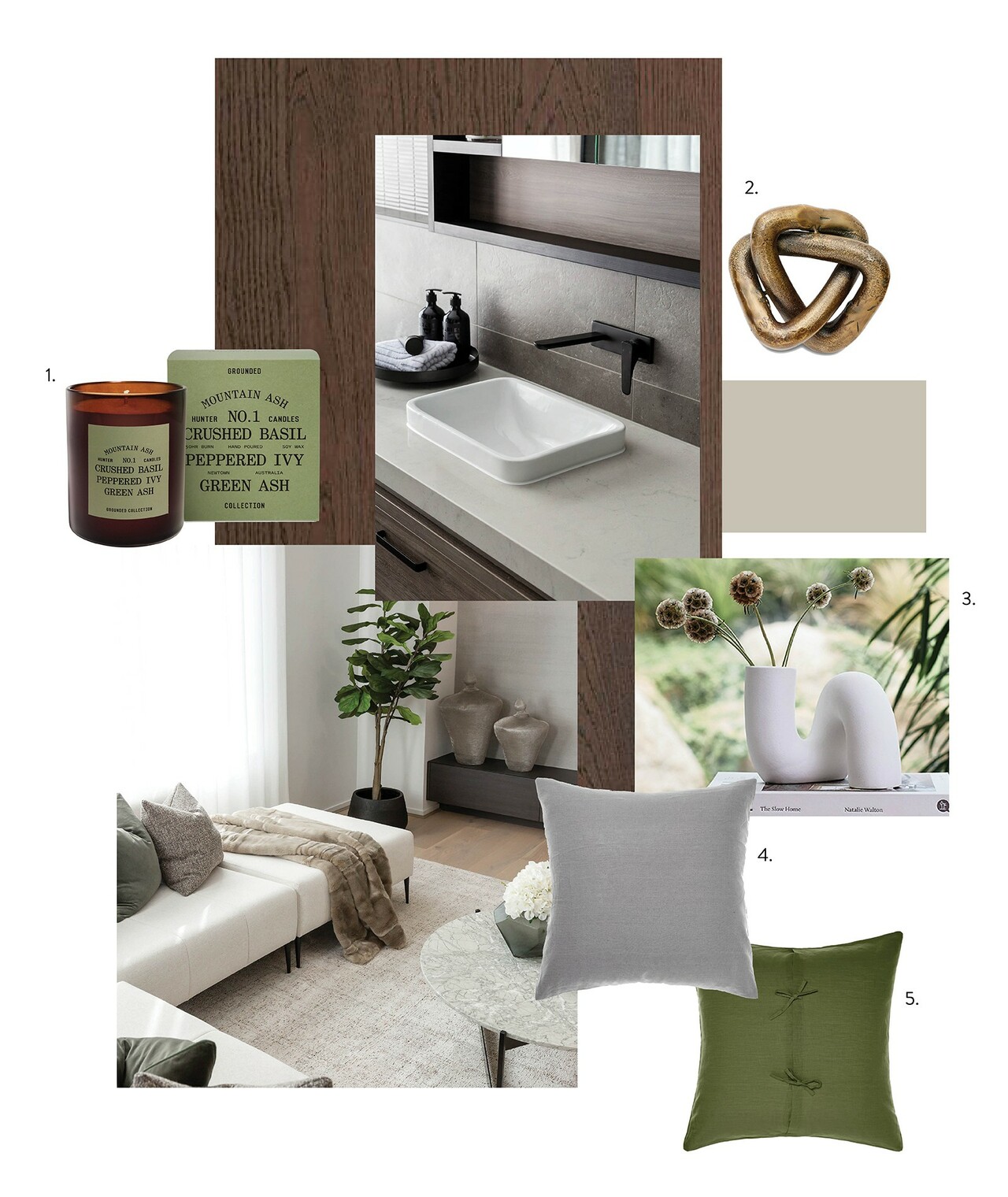
Discover the perfect accents to pair with darker timber finishes. Featured here: 1. Grounded No 1, Hunter Candles. 2. LOOP Brass Sculpture, Madras Link. 3. CURVE Matte White Vase, Madras Link. 4. Nimes Pillow in Ash, Linen House. 5. Nimes Pillow in Fern, Linen House.
Explore the art of home design in our display homes
At Carlisle Homes, we believe in creating spaces that are as unique as the families who live in them. Whether you’re inspired by rich timber tones, clean modern lines, or a blend of design styles, our versatile home designs are tailored to suit every lifestyle and aesthetic.
Our display homes showcase a wide variety of trends and timeless design elements, giving you the opportunity to see how different materials, colours, and styles come together in real-life spaces. From dark timber accents to light-filled interiors, you’ll find plenty of inspiration to bring your vision to life.
Visit one of our display homes to explore thoughtful, well-crafted interiors and discover how our expert team can help you design a home that feels truly yours. Your dream home is closer than you think - let’s bring it to life together.

Jess Hodges
Interior Design Manager
Jess' eye for design and versatile skill set have led to multiple industry award wins for Carlisle Homes, showcasing her ability to deliver high quality and tailored interior solutions.
Learn more about Jesss Hodges